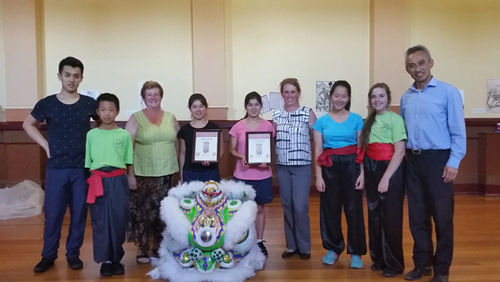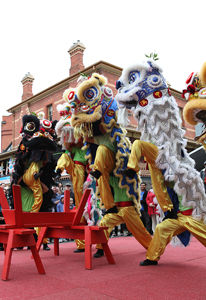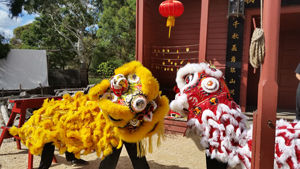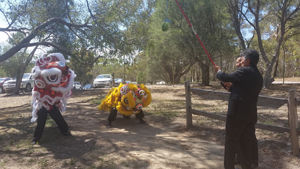Home // Activities // Lion Team Training
Lion Team Training
Lion Dance Team
Lion dance is a traditional art form of south-east Asia, with origins in the martial arts. Chinese Lion Dance is symbolic of good fortune and prosperity, and it is often used to represent the importance of overcoming the obstacles of life.
Training:
- When: Weekly day and time to be advised (subject to negotiation)
- Where: Ballarat Trades Hall- 24 Camp Street, Ballarat
- Cost: FREE to try (annual membership $12.50)
About the team
- The Lion Team is always in demand for events within the community.
- The team is looking to rebuild post COVID, ideally you would need to be Secondary School age and over as this is a very physical activity.
- Anyone interested please contact us so that we can start making arrangements for training.
Contact:
Charles Zhang (Vice President)
-
Phone: 0422 343 357
-
Email: charleszhang45@gmail.com
Venue: Ballarat Trades Hall, 24 Camp Street, Ballarat, 3350
Annual Fee for Associate Member of our Society is $12.50.
(Lion Team members need to be an associate member of the Society for insurance purposes)

Lion Team - 2017
Oscar Zhang, Tom Li, Michelle Philips, Meg Lee, Alex Lee, Jess Philips, Anna Yuan, Charlotte Edgington, Charles Zhang
|
|
|
|
|
|
The team will train regularly, once a week, during school terms . Additional training is arranged from time to time prior to special events. Anyone who is interested is welcome to come along and learn the traditional art of Chinese Lion Dancing.
The Lion Dance has great cultural significance with the Chinese people and has been a part of their history for centuries. Based on ancient martial art principles, the team practices routines which have been passed down from generation to generation. The team also learns and passes on the traditions and stories behind the dance.
History of the Lion Dancing
As with all things Chinese, the history and legends connected with Lion Dancing are many depending on the region of China where a particular style has developed. In keeping with the culture of the Chinese who first came to Ballarat during the Gold Rush of the 1850’s the Lions used by the Chinese Australian Cultural Society Ballarat Inc are southern Lions coming from the Cantonese area of China. They feature a particularly active style of performance based on the ancient Chinese martial art of Hung Gar Kung Fu which developed in association with early Shaolin Temples. The Shaolin monks combined meditation and physical prowess as a means of enlightenment which is still practiced today. Historically speaking the Lion Dance was also fostered amongst the Temples and southern Chinese people as somewhat of a cultural smoke screen which enabled monks and warriors to practice their martial arts in the guise of spiritual development and as performers for celebrations within the community at a time when the Manchurian people were extending their empire to the South and sought to prevent any form of military base developing to resist their progress. Each traditional Lion Team learns a series of steps/styles which are specific to their ancient foundations and easily identifies one team from another in terms of history.
The Chinese who share this culture, believe in three levels of spirits. The Unicorn, a somewhat smaller but similar creature to the Lions, is the guardian of the gods, a free spirit and untameable. The Dragon, is guardian of the sky hence also closely associated with water which falls from the clouds. On earth the Dragon is vulnerable except on water ie dragon boat racing and must be protected by the third spirit, the Lion, guardian of the earth and man. For this reason you will always see Dragons during street parades led by a team of southern Chinese Lions. Lions are often mistakenly called Chinese Dragons when in truth they are very different creatures, the easiest way to tell the difference is to count the legs. Just like a real lion, Chinese Lions have FOUR legs and range freely, Dragons have many more legs and move slowly from side to side similar to the flowing of a river between its banks. It is also believed this side to side movement helps to protect the Dragon from evil spirits who travel in straight lines.
Many myths and legends have also been passed down as to the origins and significance of Chinese lions, again these are specific to the foundations of each team. In our example, according to folklore a village at the foot of the mountains was constantly terrorised by hungry lions who lived in the mountain caves, harvest time was particularly fearful as the lions prowled the fields as the people tried to bring in their produce. It is said that a Buddhist monk arrived at the village with the intention of spending time meditating in the mountains. The villagers were afraid for the Monk’s safety and told him of the lions who lived in the caves. The Monk assured them he would be safe and left to seek enlightenment. The tale continues that the Monk did indeed find the caves inhabited by the Lions and rather than be eaten by them, he lived with them, prayed with them and converted the Lions to no longer eat meat!! The following year when the harvest began the Monk brought the Lions to the village to show they were no longer a threat. Rather than live in fear the villagers now shared their annual celebrations of health, wealth and prosperity with the Lions and the Monk.
During every outing our Lion Team is accompanied by a Buddhist Monk who wakes the Lions from their slumber, directs their prayer and display of respect to the gods, guides their performance and ensures they are well fed on fruits and vegetables. The Lions follow a series of movements steeped in tradition, checking for dangers before defeating an obstacle to take the food offered. A variety of foods can be eaten, each having their own significance such as lettuce or grapes for plenty, fragrant pineapple to invite people in, oranges the colour of gold for wealth and so on. As the guardians of man the Lions also set an example to be followed. Each performance features an obstacle to be overcome before the prize can be enjoyed teaching us that nothing worthwhile can be achieved without effort and that all obstacles can be defeated.






